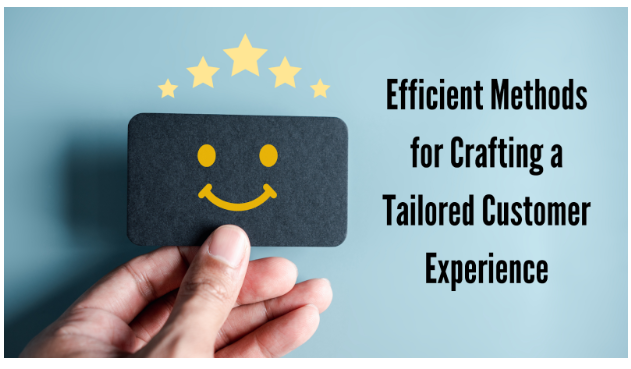10 Efficient Methods for Crafting a Tailored Customer Experience
In an era of mounting competition, a one-size-fits-all customer experience just doesn’t cut it anymore. Today’s consumers expect and demand personalization. The question is: how can resource-strapped teams make this nebulous goal a reality?
Businesses need to go the extra mile to get and keep customers. Giving personalized experiences is key – studies show 96% of people say customer service matters when picking a brand. Tailoring interactions for each customer takes work but is worth it. It leads to more loyal customers who spend more.
This article shares 10 easy ways to make a customized experience for every client. Learn simple tips to wow people with personalized attention and build long-lasting relationships.
1. Get to Know Customers Well
The first important step is to get to know your customers. Find out key details like their age, location, job, and lifestyle. Learn their values, interests, personality, and quirks. See what products they typically buy from you and how often.
Look at any support tickets, returns, or complaints recently. Know how they prefer to communicate – email, phone, text, or chat? Check out reviews and feedback online or in surveys.
Collect this data using surveys, and forms, and reviewing past purchases and interactions closely. Building customer profiles gives valuable information to personalize experiences.
2. Separate Customers into Groups
Once you have customer data, put buyers into groups with similar traits and behaviors. Use a customer insights platform to help make groups. Make groups based on location – city, state, or country. Make groups based on age, family, and job types. Separate by hobbies, favorite teams, and causes they care about. Group people by life stages like college, new parents, or retired. Divide by money spent and items bought.
Splitting into meaningful groups makes it easier to tailor communication and marketing to each one. Focus personalization on 3-5 core groups.
3. Make Content for Each Group
Create content like blog posts, videos, and social media tailored to the needs, interests, and preferences of each group. Send emails about topics highly relevant to each one. Host webinars addressing common problems or questions different groups may have. Write blog posts about the interests and hobbies of each one.
Post social media content that speaks to the pain points and desires of each one. Produce videos that resonate with the personalities of each group.
Targeted, customized content shows you understand them and aims to provide unique value.
4. Give Customized Experiences
Use customer data gathered to shape unique, relevant experiences across channels and touchpoints. Suggest products based on purchase history and interests. Send emails on topics they’ve shown interest in before. Display special offers or promotions on your website based on browsing behavior. Send personalized welcome and milestone emails when they join or purchase.
Create tailored deals and promotions. Develop loyalty program tiers based on purchase activity. Adjusting experiences based on understanding individuals shows you pay close attention to their needs and preferences.
According to a 2022 survey, 80% of consumers are more likely to purchase from a brand that provides personalized experiences. Personalization demonstrates you value your customers as individuals, not just transactions.
5. Foster Online Community
Build online groups, forums, and communities to link customers with others like them.
Some ideas: Private Facebook groups for each customer type, forums on your site for people to talk based on common interests, live webinars and Q&As for different groups, letting users share hobby stuff in galleries, local meetups, or events.
Making a community gives people a good feeling of belonging and bonding with others who share interests, backgrounds, or worries. People like connecting over common things.
6. Provide Customization Options
Give customers some control to tailor and customize their own experiences when possible. For example, let them manage communication preferences via account dashboards. Offer self-service help portals with DIY tips and resources.
Provide tools to customize purchased products. Allow customers to pick communication frequency or opt out of certain messages. Make it very easy to update contact details anytime. Let them turn profile-based recommendations on or off. Give a choice of push notification types to receive.
Giving customers the power to customize even small parts of their experience can increase satisfaction and loyalty.
7. Ask Customers for Feedback
Keep asking for customer opinions, preferences, and feedback. Do surveys after service interactions. Have online review forms. Send regular polls to get input. Ask for feedback on new product or service ideas before launching. Check social media to see what customers say. Reward people who give feedback with small perks.
Asking for input makes it easier to match communications, offerings, and experiences to what customers want. If possible, do surveys for different groups to get more specific insights.
8. Bring Customer Data Together
Use connected systems to access all customer data from every channel. Options are a CRM system, one customer database, tools that analyze data from all channels, a single view of each customer across systems, and one login for all accounts.
Having all the data in one place makes it easier to understand customers and give personalized experiences.
9. Give Customers Service Reps
Give each customer a service rep or account manager. They can learn the customer’s needs, interests, and pain points. Build rapport through regular contact. Tell customers about new offerings they may like. Quickly answer questions. Advise how to best use products based on usage. Dedicated reps treat customers like real people, not just accounts.
10. Show Customer Appreciation
Find ways big and small to show genuine gratitude and appreciation. Some ideas: Send thank you emails after purchases. Give loyal customers exclusive perks. Spotlight established customers on social media. Send handwritten thank you notes. Reward people who do surveys with small perks. Celebrate customer milestones like anniversaries.
Showing appreciation makes customers feel valued as real individuals, not just sales.
Frequently Asked Questions
1. How can I get to know my customers better?
Send surveys to ask what they like. Look at what they bought before. Talk to them to learn about their lives.
2. Why is it good to put customers in groups?
It’s easier to make things for each group based on what they like. You can focus on a few main groups.
3. How can I show customers I appreciate them?
Send thank you notes. Give small gifts sometimes. Spotlight loyal customers online. Celebrate the big milestones they reach.
Final Thoughts
Personalizing takes work but gives good results. Ways like getting to know customers, putting them in groups, making content and experiences for each group, having online communities, asking for feedback, combining data, giving reps, and showing thanks can help any business give relevant experiences. The effort is worth it. It leads to more happy, involved, and loyal customers.



